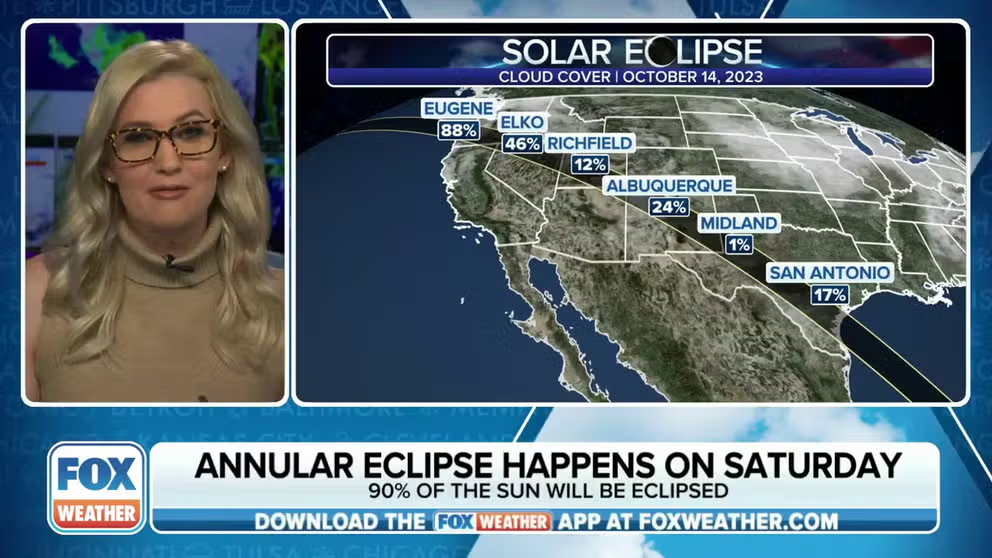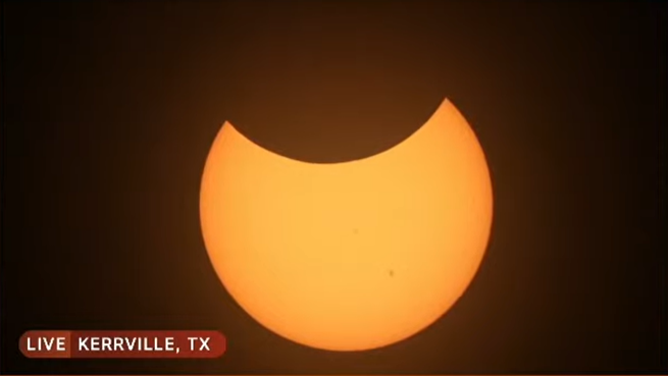Solar eclipse show begins: Most along 'ring of fire' path to have prime viewing conditions
Here's a look at the forecast along the entire eclipse path, which stretches from coastal Oregon to the Gulf Coast of Texas.
Last check of the forecast ahead of Saturday's annular solar eclipse
Millions across the West and Southwest are hoping for clear skies to see the annual solar eclipse Saturday morning. Outside the Pacific Northwest, viewing conditions are looking good.
Millions from Texas to Oregon are getting the chance Saturday morning to see the celestial show of the year as the "ring of fire" created during an annular solar eclipse will grace a swath of the western U.S. along the 125-mile-wide path of maximum eclipse.
For much of those in the path, the weather is favorable to see the show, with clear to mostly clear skies from southeastern Nevada south through the Gulf coast of Texas. Those in the Pacific Northwest are going to have to hope for a lucky break in the clouds.
LIVE FOX Weather Coverage of the solar eclipse:
The eclipse began in Oregon just after 8 a.m. PDT, with the peak "ring of fire" viewing around 9:15 a.m. PDT.
The show of near totality will then move southeast through Nevada and Utah, across New Mexico and Albuquerque and into central Texas, bringing the show to San Antonio and Corpus Christi just before noon CDT.
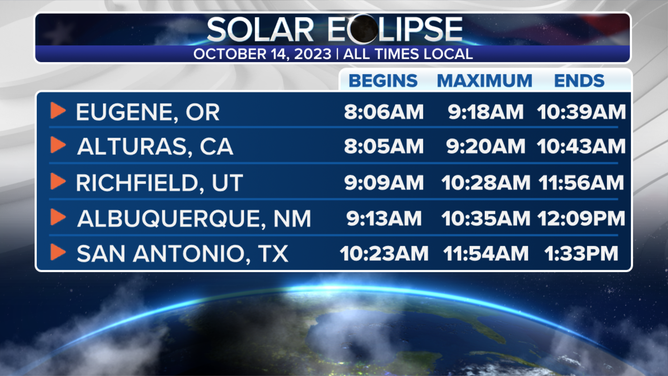
(FOX Weather)
In all, the peak show will last a few minutes in each spot, and the overall show will take roughly 45 minutes to travel from Oregon to Texas.
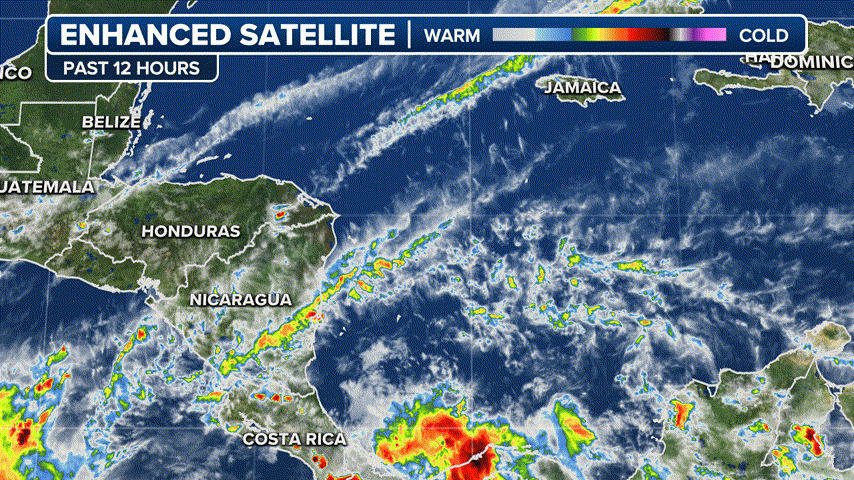
(FOX Weather)
What's happening? The Moon will pass in front of the Sun, eclipsing nearly 90% of it. This is known as an annular solar eclipse because the Moon is at the farthest point in its orbit of Earth.
During the maximum eclipse, known as annularity, the light from the Sun around the Moon creates the "ring of fire" for which the annular eclipse is known. For places not along the path of annularity, a partial eclipse will be visible.

(FOX Weather)
With an annular solar eclipse, you need to wear solar eclipse glasses during the entire event to look at the Sun. At no point is it safe to take off your glasses to watch an annular solar eclipse.
To view this eclipse, you'll need your solar eclipse glasses and a clear view of a mostly cloudless sky.
We want to hear from you! Are you traveling to see the solar eclipse? #SolarEclipse #foxweather
— FOX Weather (@foxweather) October 11, 2023
Here's a look at the forecast along the entire eclipse path:
Oregon, California and Idaho eclipse forecast
Cloud cover remains a limiting factor to view of the "ring of fire" for those in Oregon and California.

(FOX Weather)
In Oregon, the Eugene area has some scattered showers in the region, with ensuing cloud cover not making for optimal viewing conditions.
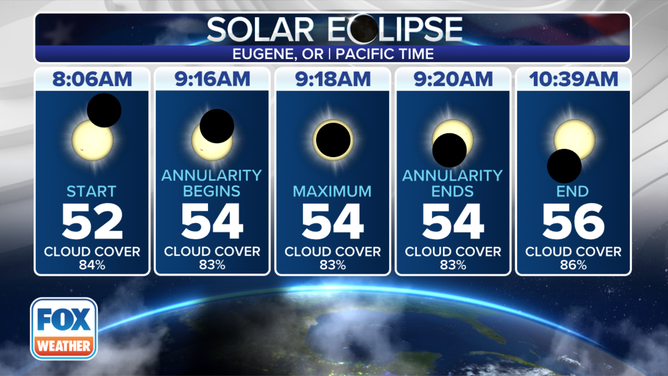
(FOX Weather)
Clouds will likely cover at least half of the sky over northeastern California too, but the odds for at least partial sunshine improve in southeastern Oregon.

(FOX Weather)
WHERE TO SEE THE 'RING OF FIRE' IN CALIFORNIA DURING THE ANNULAR SOLAR ECLIPSE
Just the southwestern sliver of Idaho is within the 125-mile-wide path of the annular solar eclipse.
Nevada eclipse forecast
Temperatures in the lower 70s will make for pleasant viewing in Nevada during annularity, but some clouds may be around to interfere with prime viewing conditions as current projections give between 30% and 50% cloud cover.
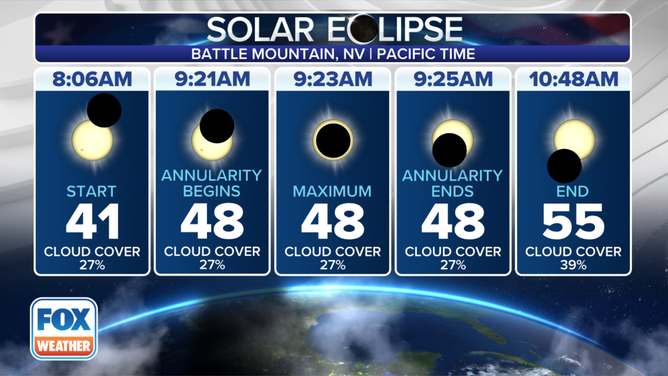
(FOX Weather)
Sky conditions do improve farther south in Nevada but outside the peak eclipse coverage.

(FOX Weather)
Utah eclipse forecast
The swath of the annular solar eclipse includes Canyonlands National Park, and two more popular national parks are just outside the "ring of fire."

(FOX Weather)
Sky cover forecasts have improved as of Friday morning, with now mostly sunny skies expected ahead of the eclipse and cloud cover estimated around 25% or less.

(FOX Weather)
Arizona and Colorado eclipse forecast
The eclipse will pass through the Four Corners, where Utah, Colorado, New Mexico and Arizona meet and conditions remain quite favorable.
The latest sky cover projections just show a few clouds in the region amid plenty of sunshine.
WHERE TO SEE 'RING OF FIRE' IN COLORADO DURING OCTOBER ANNULAR ECLIPSE

(FOX Weather)
New Mexico eclipse forecast
New Mexico is expected to be a hot spot for eclipse viewers because of the good weather for October and the Albuquerque International Balloon Fiesta.
Temperatures will be pleasant in the upper 70s and lower 80s with partly to mostly sunny skies, including in Albuquerque, with just a few clouds around.

(FOX Weather)
Albuquerque may see some passing high clouds, but it'll be a race as skies slowly clear through the morning and latest projections show just 25-30% cloud cover there around eclipse time and most of the clouds will just be high thin cirrus clouds.
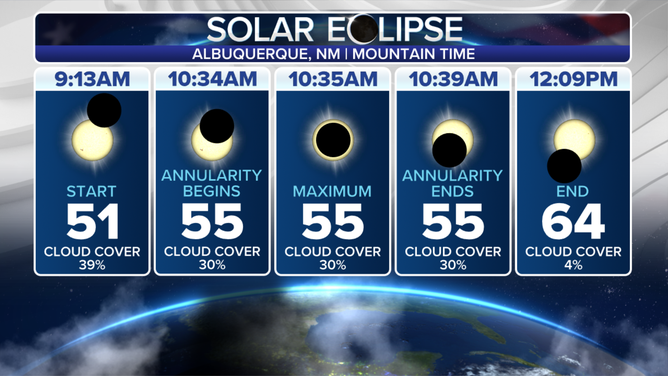
(FOX Weather)
FOX Weather meteorologist Stephen Morgan and correspondent Max Gorden will be live in Albuquerque for the eclipse on Saturday.
Texas eclipse forecast
The final stretch of the solar eclipse will be in the Lone Star State from the Texas Panhandle to the Gulf of Mexico.

(FOX Weather)
The FOX Model shows nearly crystal clear skies over most of Texas for the eclipse, which will provide an excellent eclipse viewing experience for skygazers.

(FOX Weather)
The exception is a few clouds possibly hugging the Gulf Coast and South Texas. In Corpus Christi, more than half the sky may be obscured.
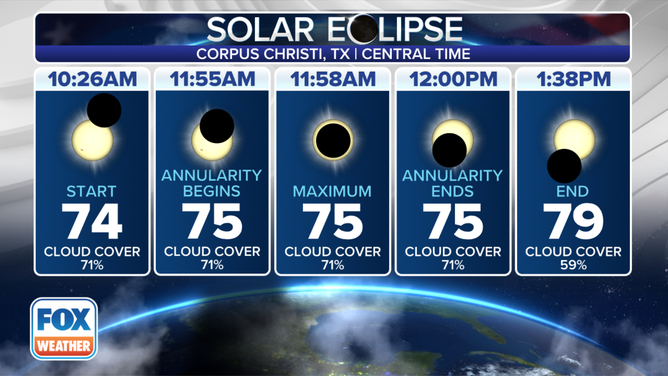
(FOX Weather)
FOX Weather correspondent Robert Ray will be live in San Antonio for the eclipse on Saturday.
